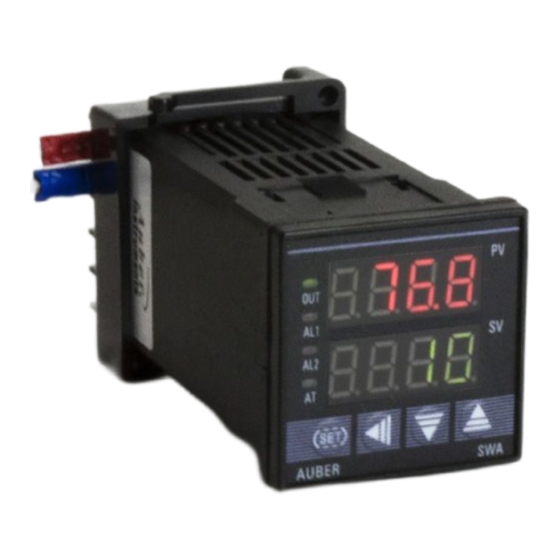Auber Instruments SWA-2441A Manual de instruções - Página 2
Procurar online ou descarregar pdf Manual de instruções para Controlador de temperatura Auber Instruments SWA-2441A. Auber Instruments SWA-2441A 6 páginas.

AUBER INSTRUMENTS
contact and other may need N.C. contact switch. Please see Fig. 7 and 9 for
examples.
3.3 Control output connection
The relay output of SWA-2441A can be used to turn on an external contactor or
a solenoid valve. This controller can also drive a small heater/load directly, if
this load draws less than 10A/120V.
3.3.1 Connecting the load through a contactor: Assuming the controller is
powered by 120V AC and the contactor has a 120V AC coil, jump a wire
between terminals 9 and 7. Connect terminal 10 to one lead of the coil and
terminal 6 to the other lead of the coil. Please see Figure 6 for example.
3.3.2 Connecting the heater (or cooler) directly from the internal relay.
Assuming the controller and the load (heater or cooler) are powered by the
same voltage. Jump a wire from terminal 9 to 7. Connect terminal 10 to the one
lead of the load and terminal 6 to the other lead of the load. Please see Figure 7
for details.
3.4 For first time users without prior experience with PID controllers, the
following notes may prevent you from making common mistakes.
3.4.1 Power to the relay output does not flow through terminal 6 and 7 of the
controller. The controller consumes less than 2 watts of power, and it only
provides a control signal to the relay. Therefore, wires in the 18 to 26 gauge
range should be used for providing power to terminals 6 and 7. Thicker wires
may be more difficult to install.
3.4.2 The control relay output and the alarm output are dry single pole switches.
They do not provide power by itself. External power source is needed for wiring
the relay outputs. See examples 6 or 7 for details.
3.4.3. The output of this controller is controlled by regulating the duration of on
time for a fixed period of time. It is not controlled by regulating amplitude of the
voltage or current. This is often referred as time proportional control. For
example, if the cycle rate is set for 100 seconds, a 60% output means controller
will switch on the power for 60 seconds and off for 40 seconds (60/100 = 60%).
Almost all high-power control systems use time proportional control because
amplitude proportional control is too expensive and inefficient.
4. Front Panel and Operation
Figure 2. Front panel.
1.
PV display: Indicates the sensor read out, or process value (PV).
2.
SV display: Indicates the time when timer is used. If timer is deactivated, it
indicates the set temperature (SV). In manual control mode, an "H" is
displayed on the most left digit to indicate number is for percentage of
output (%).
3.
Output indicator: It is synchronized with control output (terminal 9 and 10),
and the power to the load. When it is on, the heater (or cooler) is powered.
4.
AL1 indicator: It is synchronized with alarm 1 relay (AL1). When timer is on,
it works as the timer relay output indicator. When timer is deactivated, it
lights when Alarm 1 condition meets.
2019.01
5.
AL2 indicator: It is synchronized with alarm 2 relay (AL2). It lights when
Alarm 2 condition meets.
6.
Auto-tune indicator: It lights up when auto-tune starts.
7.
SET key: Press and hold this key for 3 seconds will enter the temperature
control parameter setting mode. When the controller is in temperature, or
timer parameter setting mode, press this key momentarily will lead the
display to the next parameter.
8.
Automatic/Manual function key/Data shift key ◄: press ◄ for 3 seconds to
enter manual tuning mode. Press ◄ for 3 seconds again to exit.
9.
Decrement key ▼: Decreases numeric value of the setting value. Press for
3 seconds to enter the timer setting mode.
10. Increment key ▲: Increases numeric value of the setting value. Press for 3
seconds to enter the temperature setting mode.
4.1 Display Modes
Display mode 1: Normal operation display.
PV is the abbreviation for Process Value. SV is the abbreviation for Set Value.
When the power is turned on, the upper display window shows the measured
temperature value. If the timer is used, the lower window shows set timer value.
When timer starts, it shows the time as it counts up or down. If the timer is
disabled (INT = 0), the lower display shows the set temperature.
Display mode 2: Changing temperature set value (SV)
Press the ▲key for 3 seconds, and then release it. The decimal point on the
lower right corner will start to flash. Press the ▼or ▲ key to change SV until
the desired value is displayed. If the change of SV is large, press the ◄ key to
move the flashing decimal point to the desired digit that needs to be changed.
Then press the ▼or ▲key to start changing SV from that digit. The decimal
point will stop flashing after no key is pressed for 3 seconds. The changed SV
will be automatically registered without pressing the SET key.
Display mode 3: Timer parameter set up.
Press the ▼ key for 3 seconds to change the display status into timer
parameter setting mode. The upper display window shows the timer parameter
symbol to be changed, the lower display shows its value. Press the ◄, ▼or ▲
to change the setting. Then, press SET to go to next parameter. If no key is
pressed for 10 seconds, the display will return to mode 1 automatically. The
change of value will take effect without the need for pressing the SET key. See
4.14 to 4.16 for more details.
WWW.AUBERINS.COM
P2/6
